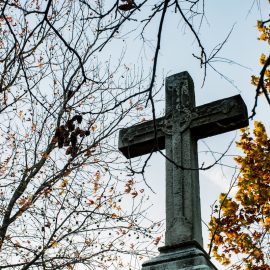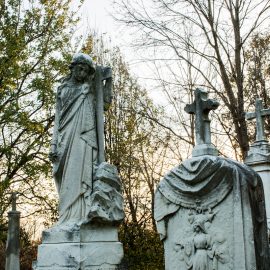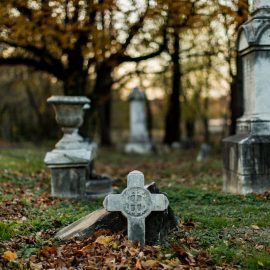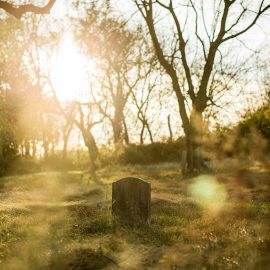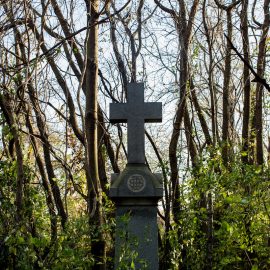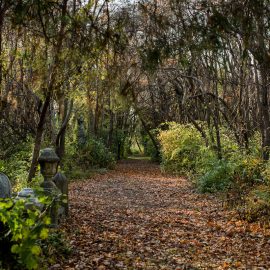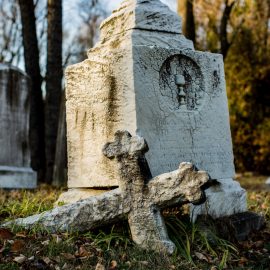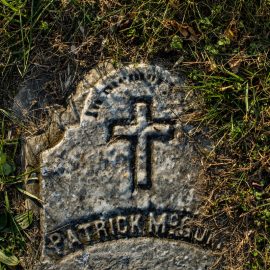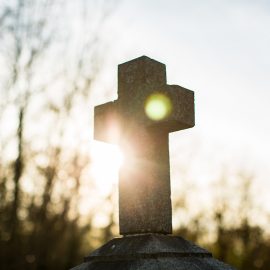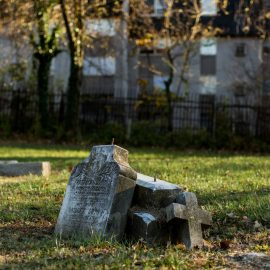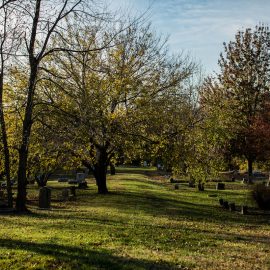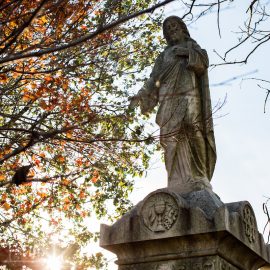News & Community
You Are Here
Scenes from an Irish wake and Day of the Dead parade.
Mourning After
Lemmon Street
November 5, 2016
Inside the Hollins Market rowhouse once owned by James and Sarah Feeley, there’s a bottle of Jameson whiskey, playing cards, a pipe, and loose tobacco sitting on the table next to the door. Standing against the living room wall, there’s a Catholic priest in a black cassock—well, a mannequin in a priest’s cassock. And, laying on a wooden slab alongside the living room wall, there’s a smaller mannequin covered in lace, with rosary beads in hand, surrounded by candles and representing the Feeleys’ son, William, who died 12 days before St. Patrick’s Day in 1876.
“It wasn’t unusual for people to have 10 or 11 children and five that died,” says Cecilia Wright, an Irish wake expert, presenting this morning at the Feeleys’ restored home, which today serves as part of the Irish Shrine and Railroad Workers Museum. “Several of the Feeleys’ children died.”
Later, there will be a tour of tucked-away St. Peter’s Cemetery in West Baltimore, the 22-acre resting place of many early Irish immigrants, including the ancestors of some of those in attendance today. (Philip Berrigan, a World War II veteran and priest who famously protested the Vietnam War, is one of the more well-known Irish Catholics buried at St. Peter’s.) But at the moment, Wright is explaining the traditions and superstitions of wakes brought by the Irish to the U.S. and Baltimore, where so many worked for the nearby B&O Railroad, as James Feeley did.
Someone had to sit with the body for three days, for example, literally on watch to see if the deceased “awakened,” which is how the term wake originated. Candles were placed at the head, feet, and sides of body, Wright notes, to ward off evil spirits. Windows were opened to allow the soul to depart for heaven and then closed to prevent the spirit from returning.
Not all Irish wakes were the same, however. The death of a child was a much more somber occasion than the passing of a beloved older relative who had lived a full life—one worth celebrating with three days of song, food, games, contests of strength, and serious drinking. “It wasn’t considered a good wake if at least one fight didn’t break out,” says Wright.
A few people at the small but packed museum recall the authentic Irish wakes of their own Baltimore neighborhoods, which admittedly seem somewhat surreal in hindsight. “I don’t remember any funeral homes in those days—the living room was the funeral parlor—and the body was carried straight to the cemetery,” says Jackie Waltemeyer. Her cousin, Thelma Graziano (whose parents were Irish), remembers that Irish families put funeral wreaths on their door when someone in the house died. “Even when I got married and moved into my own home, my Irish mother would never allow me to put even a Christmas wreath on the front door,” says Graziano, who grew up in Northeast Baltimore. “She hated seeing any kind of wreath on a door her whole life.”
Luke McCusker, director of the museum, heard tales of his family’s Irish wakes from his father.
“He still tells the story of playing and hiding beneath the sawhorses in the living room as a boy,” McCusker says with a wry smile, shaking his head. “While my great-grandmother was laying on a board above his head.”
All Hallow’s Eve
Linwood Avenue
October 29, 2016
On a warm Saturday night, exquisite, sombrero-clad Día de los Muertos skeletons on stilts are bouncing through a packed Patterson Park, leading a quarter-mile-long parade propelled by mariachi music up front and West Baltimore marching bands in the rear.
The 17th Great Halloween Lantern Parade & Festival, organized by the Creative Alliance, is a mashup of cultures this year. It’s both an American Halloween costume party and a Mexican Día de los Muertos, aka Day of the Dead, celebration.
The nearly all-day event in heavily Latino Southeast Baltimore began with Lantern and Day of the Dead altar-making workshops—including assistance from Artesans Mexicanas, an arts collective of local immigrant women—as well as hayrides and a kids’ costume contest. The parade, meanwhile, is a wild moving scene of glow-in-the-dark floats, monsters, music, Baltimore-area schoolchildren, and piñata bashing.
Also on hand: plenty of food trucks (one appropriately offering crab cake tacos), American and native-Mexican crafters, plus a beer garden.
Later, as the parade wraps up, the mariachi band Rey Azteca—two trumpets, two violins, and two guitars—takes to the outdoor stage, accompanied by brightly dressed Mexican folk dancers. After several numbers and shouts of, “Otro! Otro!” (“Another! Another!”), the band returns for an encore, performing “México Lindo y Querido,” a famous mariachi and ranchero ode to the old country.
In front of the stage sits a massive altar of marigolds, candles, fruit, bread, decorated skulls, and framed photographs of departed loved ones.
Día de los Muertos is really much different than Halloween, says Erika Torres, watching Rey Azteca perform with her godson and 77-year-old mother, an immigrant from a town outside of Mexico City who is wearing a traditional handmade dress for the occasion. “In Mexico, it lasts three days and it’s very spiritual,” Torres explains. “It’s a time to pray and talk with our family members who have passed, but remain alive in our hearts.”
Fells Point-based painter and sculptor Ignacio Herrera, like others here, describes Día de los Muertos as a religious mix of Aztec and Catholic influences and rituals. The holiday is not just a remembrance of lost loved ones, he says, but also that death is a part of life and God is close at hand.
“The Aztecs used to play games and fight to death,” Herrera says. “It was believed that the real winners were those who died because they got to go be with God.”
